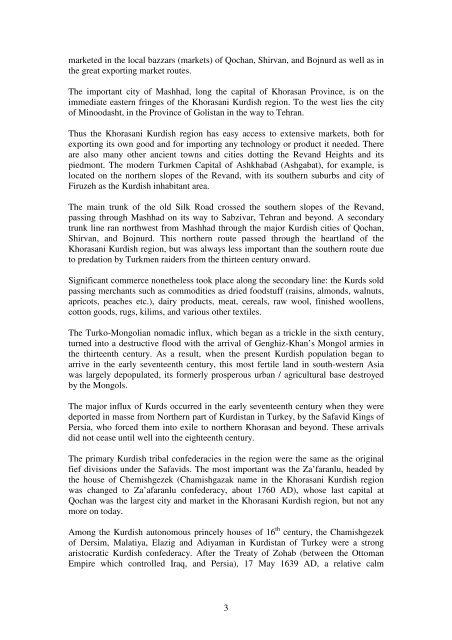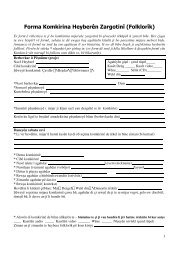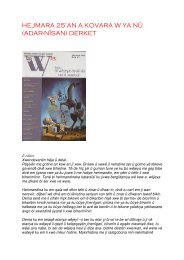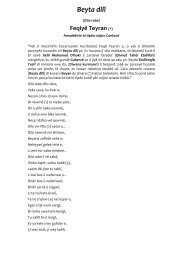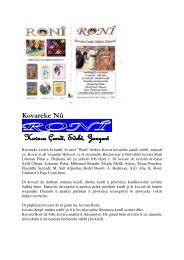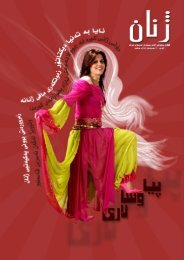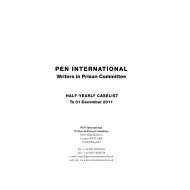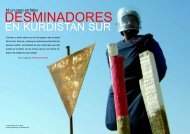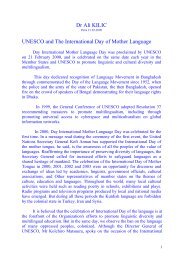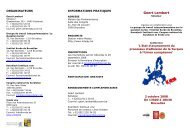The Kurds in Khorasan, North-east of Iran - Pen-Kurd
The Kurds in Khorasan, North-east of Iran - Pen-Kurd
The Kurds in Khorasan, North-east of Iran - Pen-Kurd
Create successful ePaper yourself
Turn your PDF publications into a flip-book with our unique Google optimized e-Paper software.
marketed <strong>in</strong> the local bazzars (markets) <strong>of</strong> Qochan, Shirvan, and Bojnurd as well as <strong>in</strong>the great export<strong>in</strong>g market routes.<strong>The</strong> important city <strong>of</strong> Mashhad, long the capital <strong>of</strong> <strong>Khorasan</strong> Prov<strong>in</strong>ce, is on theimmediate <strong>east</strong>ern fr<strong>in</strong>ges <strong>of</strong> the <strong>Khorasan</strong>i <strong>Kurd</strong>ish region. To the west lies the city<strong>of</strong> M<strong>in</strong>oodasht, <strong>in</strong> the Prov<strong>in</strong>ce <strong>of</strong> Golistan <strong>in</strong> the way to Tehran.Thus the <strong>Khorasan</strong>i <strong>Kurd</strong>ish region has easy access to extensive markets, both forexport<strong>in</strong>g its own good and for import<strong>in</strong>g any technology or product it needed. <strong>The</strong>reare also many other ancient towns and cities dott<strong>in</strong>g the Revand Heights and itspiedmont. <strong>The</strong> modern Turkmen Capital <strong>of</strong> Ashkhabad (Ashgabat), for example, islocated on the northern slopes <strong>of</strong> the Revand, with its southern suburbs and city <strong>of</strong>Firuzeh as the <strong>Kurd</strong>ish <strong>in</strong>habitant area.<strong>The</strong> ma<strong>in</strong> trunk <strong>of</strong> the old Silk Road crossed the southern slopes <strong>of</strong> the Revand,pass<strong>in</strong>g through Mashhad on its way to Sabzivar, Tehran and beyond. A secondarytrunk l<strong>in</strong>e ran northwest from Mashhad through the major <strong>Kurd</strong>ish cities <strong>of</strong> Qochan,Shirvan, and Bojnurd. This northern route passed through the heartland <strong>of</strong> the<strong>Khorasan</strong>i <strong>Kurd</strong>ish region, but was always less important than the southern route dueto predation by Turkmen raiders from the thirteen century onward.Significant commerce nonetheless took place along the secondary l<strong>in</strong>e: the <strong><strong>Kurd</strong>s</strong> soldpass<strong>in</strong>g merchants such as commodities as dried foodstuff (rais<strong>in</strong>s, almonds, walnuts,apricots, peaches etc.), dairy products, meat, cereals, raw wool, f<strong>in</strong>ished woollens,cotton goods, rugs, kilims, and various other textiles.<strong>The</strong> Turko-Mongolian nomadic <strong>in</strong>flux, which began as a trickle <strong>in</strong> the sixth century,turned <strong>in</strong>to a destructive flood with the arrival <strong>of</strong> Genghiz-Khan’s Mongol armies <strong>in</strong>the thirteenth century. As a result, when the present <strong>Kurd</strong>ish population began toarrive <strong>in</strong> the early seventeenth century, this most fertile land <strong>in</strong> south-western Asiawas largely depopulated, its formerly prosperous urban / agricultural base destroyedby the Mongols.<strong>The</strong> major <strong>in</strong>flux <strong>of</strong> <strong><strong>Kurd</strong>s</strong> occurred <strong>in</strong> the early seventeenth century when they weredeported <strong>in</strong> masse from <strong>North</strong>ern part <strong>of</strong> <strong>Kurd</strong>istan <strong>in</strong> Turkey, by the Safavid K<strong>in</strong>gs <strong>of</strong>Persia, who forced them <strong>in</strong>to exile to northern <strong>Khorasan</strong> and beyond. <strong>The</strong>se arrivalsdid not cease until well <strong>in</strong>to the eighteenth century.<strong>The</strong> primary <strong>Kurd</strong>ish tribal confederacies <strong>in</strong> the region were the same as the orig<strong>in</strong>alfief divisions under the Safavids. <strong>The</strong> most important was the Za’faranlu, headed bythe house <strong>of</strong> Chemishgezek (Chamishgazak name <strong>in</strong> the <strong>Khorasan</strong>i <strong>Kurd</strong>ish regionwas changed to Za’afaranlu confederacy, about 1760 AD), whose last capital atQochan was the largest city and market <strong>in</strong> the <strong>Khorasan</strong>i <strong>Kurd</strong>ish region, but not anymore on today.Among the <strong>Kurd</strong>ish autonomous pr<strong>in</strong>cely houses <strong>of</strong> 16 th century, the Chamishgezek<strong>of</strong> Dersim, Malatiya, Elazig and Adiyaman <strong>in</strong> <strong>Kurd</strong>istan <strong>of</strong> Turkey were a strongaristocratic <strong>Kurd</strong>ish confederacy. After the Treaty <strong>of</strong> Zohab (between the OttomanEmpire which controlled Iraq, and Persia), 17 May 1639 AD, a relative calm3


